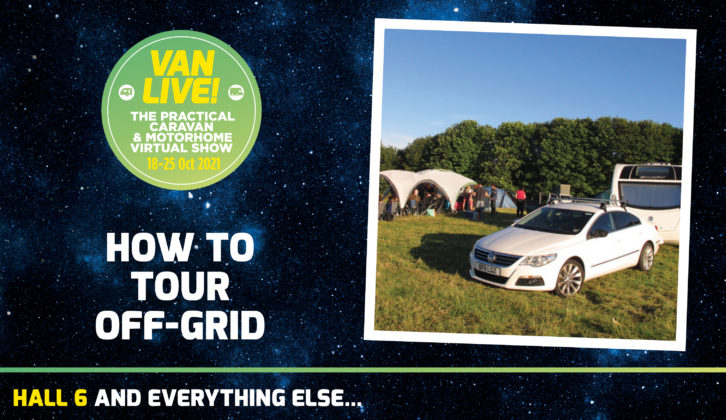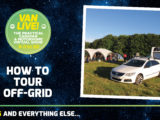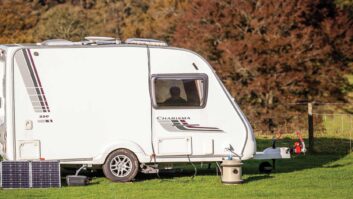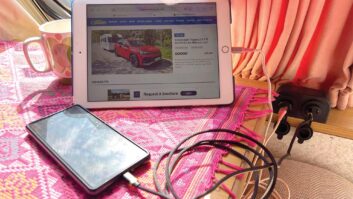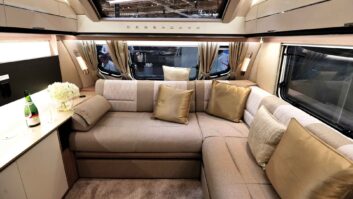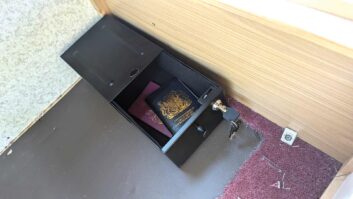“I’m not tight, I just don’t like wasting money.” That’s what I tell my family as I dash around the house, switching off lights or turning down the thermostat, with the sort of exaggerated huffing that could win me an Oscar if overacting were a category.
It’s similar in the van when we off-grid, but there it’s about preserving battery power and gas, as I try to make both resources last as long as possible.
There’s a skill to off-gridding, which took me a while to develop. But the effort was worth it, as I’ve stayed on some sensational facility-free sites over the years.
The camping X-factor
By definition, off-grid means you have no electric hook-up, Wi-Fi or those other luxuries we’ve come to expect. Most often, a lack of site facilities forces you to rely on your caravan’s washroom, too.
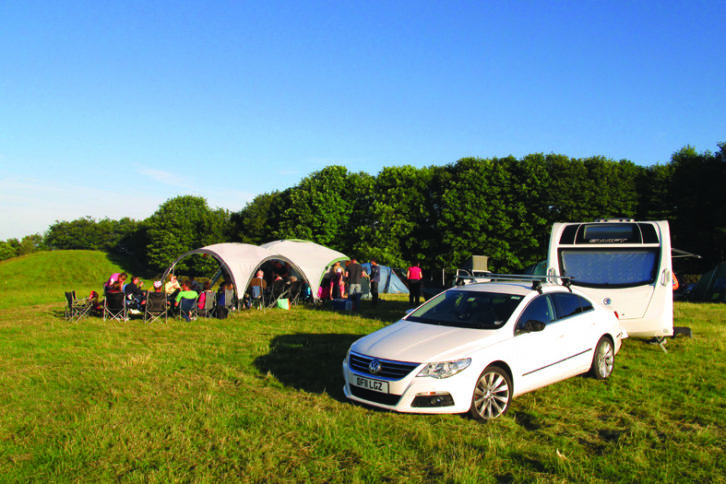
The payback for these little ‘hardships’ is immense, though. The best off-grid sites (sometimes Club CSs and CLs) are small, wild and set in the most extraordinary locations, where a big, commercial site simply wouldn’t be allowed.
Yes, you can save a small fortune in campsite fees, but it’s more to do with the quality of the sites. Usually rural and remote, they often have a camping X-factor that the bigger, facility-filled parks can’t compete with.
And off-gridding doesn’t have to mean roughing it – you can power your hob, oven, heating and fridge with gas, and lighting and TV with battery power. It’s really just your caravan microwave and electric hotplate that you’ll say au revoir to, for this trip at least.
I know from personal experience that running out of gas or battery power does little to enhance a caravanning holiday, so we’ve pulled together some top tips to make sure your next off-grid trip is a success.
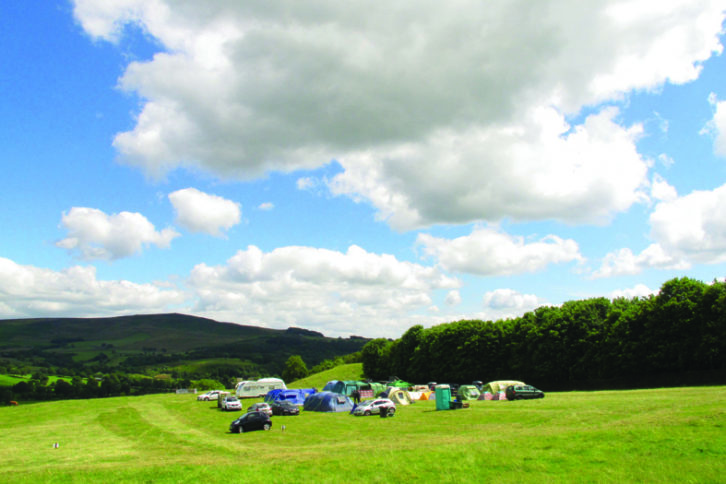
Gas
Ensure that you have sufficient gas for your outing. This can be a bit awkward without investing in a second gas cylinder, so that you’ve always got a full one. You really don’t want to be swapping a third-full bottle for a full one with your Calor distributor.
One solution to this quandary is to invest in a self-refill system, such as Safefill or Gaslow. Both involve buying the bottle(s) – and in the case of Gaslow, the installation – which you can then fill up yourself at any of the UK’s 240 LPG Autogas fuel stations, such as Morrisons, for example You can find out more at drivelpg.co.uk.
Not only can you top up your cylinder at any time, but the gas costs significantly less. When we looked, Calor cost around £2 a litre, while Autogas was just 60p a litre. If you can find a domestic gas supplier, you can also knock the VAT off that.
You have a choice of two types of bottle gas: butane or propane. One litre of butane contains 12% more energy than one litre of propane, but the most important difference for caravanners is the minimum temperature at which they vaporise.
Butane vaporises at temperatures down to minus 2°C, while propane vaporises as low as minus 42°C. Touring in a typical British winter could easily cause a butane-powered system to stop working, while you’d have to be visiting Siberia to prevent a propane system from functioning.
Electricity
With no mains hook-up, you’re going to be relying on your leisure battery for all of your electrical power. This is the main reason why many serious off-gridders will often install a second leisure battery, fitted with manual or auto switchover.
The NCC has set up a Verified Leisure Battery Scheme, which offers clear guidance on a battery’s capacity.
- Category A batteries have higher storage capacity and are deisgned for caravanners who tend to camp away from an electric hook-up.
- Category B batteries are for those who typically stay on pitches with an electric hook-up, but also need greater power for devices such as motor movers.
- Category C batteries are designed for use over a short time to power basic, low-demand equipment.
Start by fitting the largest leisure battery you can find, ideally a Category A.
Your battery power (reserve) is measured in ampere/hours (Ah), and an ideal size for off-gridders is 110Ah. This is a large item, so check carefully that it will fit your leisure battery locker. Bear in mind that a second battery can also take up 20kg of your payload allowance.
A leisure battery has much thicker lead plates inside than those provided in a car battery. Typically, the heavier a battery is, the more lead it contains and the better-suited to off-grid caravanning.
Avoid letting the charge in your lead-acid leisure battery get too depleted. It will last longer if it’s regularly recharged from 75% capacity, rather than letting it go down to 50% or below.
The latest lithium batteries are perfect for off-gridding. Lithium iron phosphate (LiFePO4) technology creates powerful and lightweight batteries that can be discharged much further than lead-acid batteries, with no detrimental effects.
Of course, there’s always a downside, and that’s the cost. A few years ago, lithium leisure batteries cost around £2000. Prices are now down to about £700, but that’s still multiples of a good-quality standard battery.
The control panel in most vans displays the level of charge in the leisure battery. It might not always be the most accurate indicator of charge, so get your technician to compare it with a voltmeter reading at service time.
Typically, a 12V battery is fully charged when the meter reads 12.7V, 75% charged when the display says 12.4V and 50% charged at 12.2V. This is the time to recharge it.
A gentle trickle charge will suit your leisure batteries better than fast charging. Smart chargers, such as those from CTEK, prevent overcharging, which can lessen a battery’s lifespan.
It’s important to keep batteries properly charged through the off-season and when in storage. Use a smart charger where possible, or remove the battery from the caravan and store it in a well-ventilated room, checking its power levels periodically. Remember that trackers and alarms rely on leisure battery power, so check before you remove it.
For ultimate performance, it’s best to keep non-sealed batteries topped up with fluid, and to ensure tha bttery posts are clean and the clamps are fitted tightly.
Finally, remember that leisure batteries are less efficient in cold conditions (their power figure is calculated at 25°C). As a rule, every 1°C fall below 25°C results in a 1% decline in battery performance.
YOU COULD TRY…
Solar panels
Solar panels can keep your leisure battery topped up with power, so are perfect for off-grid caravanners.
Photovoltaic panels create electricity from all light, not just direct sunlight, so they will generate current in winter; albeit a fraction of what they’d make on a bright summer day.
They can be fixed to the caravan roof (either bonded or bolted on), or they’re available in portable metal frames, which can be moved around to make the best use of available sunlight. Remember to move them at night during the summer, so they can make the most of the early morning sunlight before you rise.
Buy a good brand from a reputable dealer. Look for a panel with international IEC 61215 quality certification, and buy from a dealer offering a good warranty. Solar Technology International, for example, offers buyers a 25-year performance warranty.
The angle of your panel hugely affects its performance. The optimum angle varies, depending on location and time of year. The best angles have been calculated and can be seen online at solarelectricityhandbook.com.
All panels over 18W will require a voltage regulator/controller. We recommend buying a (slightly more expensive) Maximum Power Point Tracking charge controller, because these can eke out 20% more power from your system.
Aim to fit one that is capable of keeping your system charged; typicalls this will be a 100-20W set-up.
Your maximum charging rate will be the wattage of the panel multiplied by the hours of useful light. In summer, a 150W panel might experience five hours of strong light, so 150W x 5 hours = 750W.
Watching TV for three hours might use 3 x 35W = 105Wh and LEDs might consumer 5 x 5W = 25Wh. The water pump and heating fan require much more power. You’ll get to know how many devices you can use.
You might find a cheap solar panel online, but the experts recommend buying from a recognised UK supplier. Investing a bit more on carefully sourced panels pays dividens in power output, longevity and aftercare.
An AGM-type leisure battery is particularly efficient when used with a solar panel for topping up.
YOU COULD TRY…
Water
All but the most extreme off-grid sites will have a water supply, but we would always recommend taking a large canister of drinking water with you, especially for campsites that you haven’t visited before.
Save power
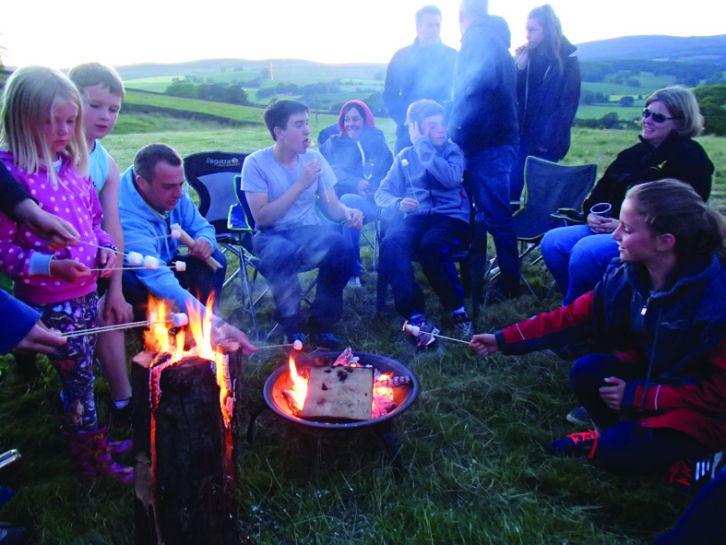
You can take steps to limit the amount of power you use. A van with LED lighting uses a fraction of the power consumed in one with traditional tungsten bulbs. LED light conversions are a relatively easy job for the keen DIYer. Likewise, modern LED TVs consume less power than other types.
Avoid activating your water pump every time you turn on a tap to wash your hands, by taking a bottle of hand sanitiser. This saves water, too.
Hot summer days often lead to cool evenings. Rather than flicking the heating on, consider taking some ‘unseasonal’ clothing along, such as bedsocks, for inside the van. Alternatively, take a firepit (if allowed by the site) and sit outside the van later into the evening. Shower in the morning, so the battery has all day to recharge. Try to avoid using your motor mover when you arrive on site, as this consumers a lot of battery power.
Powered by 12V
Lots of electrical appliances that would be powered by 240V mains electricity at home are available in 12V versions, and these are perfect for off-grid fans. For example, 12V kettles, toasters and hairdryers can be obtained from all good caravan dealerships.
Inverters
Inverters turn 12V DC battery power into a 230V AC output. This allows you to run household appliances in your caravan when off-grid. There are two types of inverter: quasi (or modified) sine wave inverters and pure sine wave inverters.
Quasi versions power most appliances, including microwaves, kettles, hairdryers and hair straighteners, but some thyristor-controlled equipment will only run from a pure sine wave inverter.
Calculate the maximum power consumption you’ll need (in watts) and choose an inverter accordingly.
Remember that an inverter typically discharges your battery much faster than when using 12V equipment, so you might want to have your tow car hooked up and engine running to minimise the loss of charge. What price frizzy hair?
Save cash

A typical night rate at a mainstream campsite is around £25. A top-notch small site with fewer facilities and no hook-up costs £10-£12 per night; sometimes as little as £8. Both will offer discounts for a week-long booking, so the totals might typically be £150 versus £65.
Take a look at my tips to help you get the most from an off-grid getaway too.
You’re in Hall 6 Advice Lounge & Events Theatre at Van Live! See what else is happening on stage, or take me to the Show Guide.
Future Publishing Limited, the publisher of practicalcaravan.com, provides the information in this article in good faith and makes no representation as to its completeness or accuracy. Individuals carrying out the instructions do so at their own risk and must exercise their independent judgement in determining the appropriateness of the advice to their circumstances. Individuals should take appropriate safety precautions and be aware of the risk of electrocution when dealing with electrical products. To the fullest extent permitted by law, neither Future nor its employees or agents shall have any liability in connection with the use of this information. You should check that any van warranty will not be affected before proceeding with DIY projects.
The best off-grid campsites are small, wild and set in the most extraordinary locations
